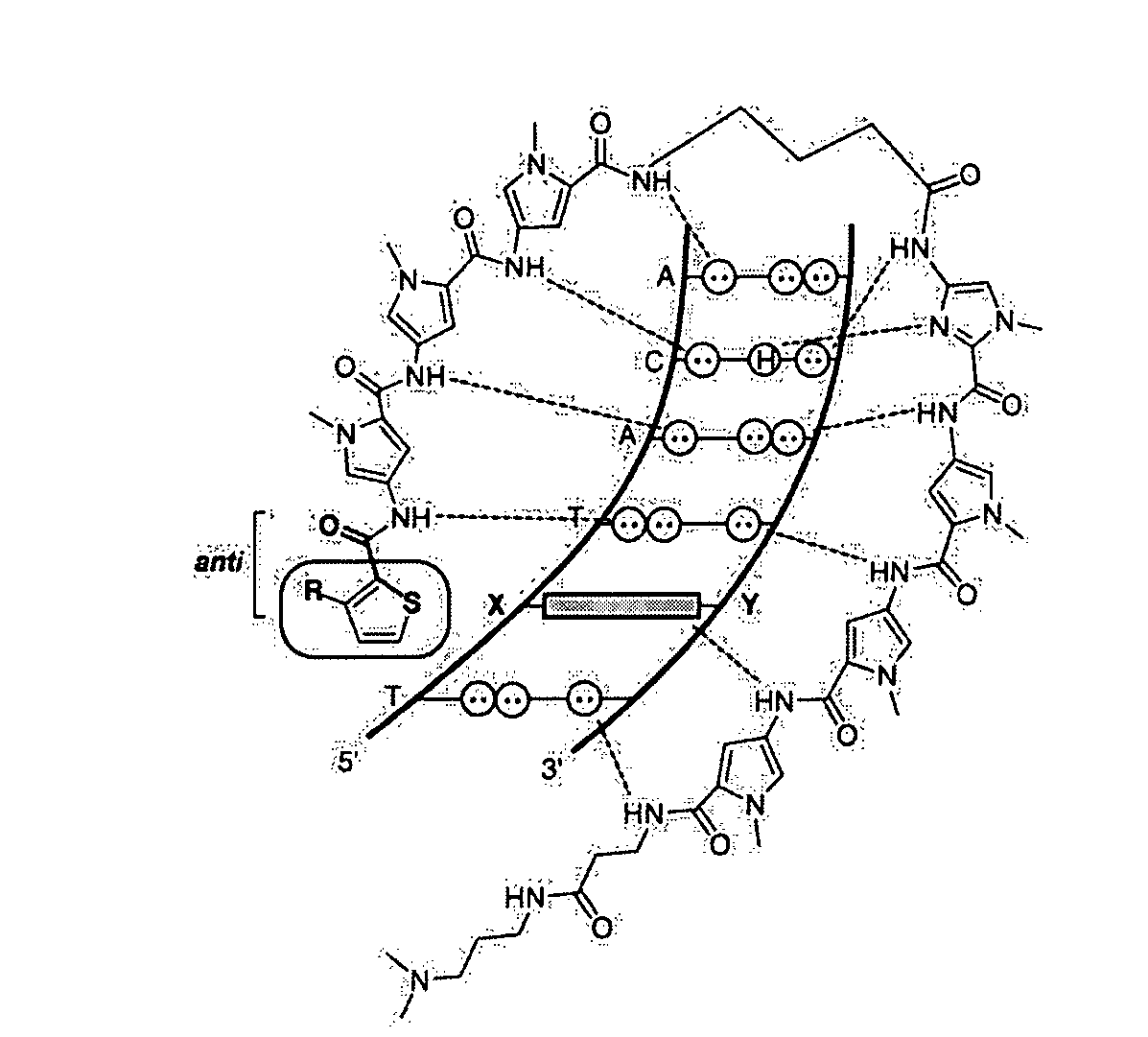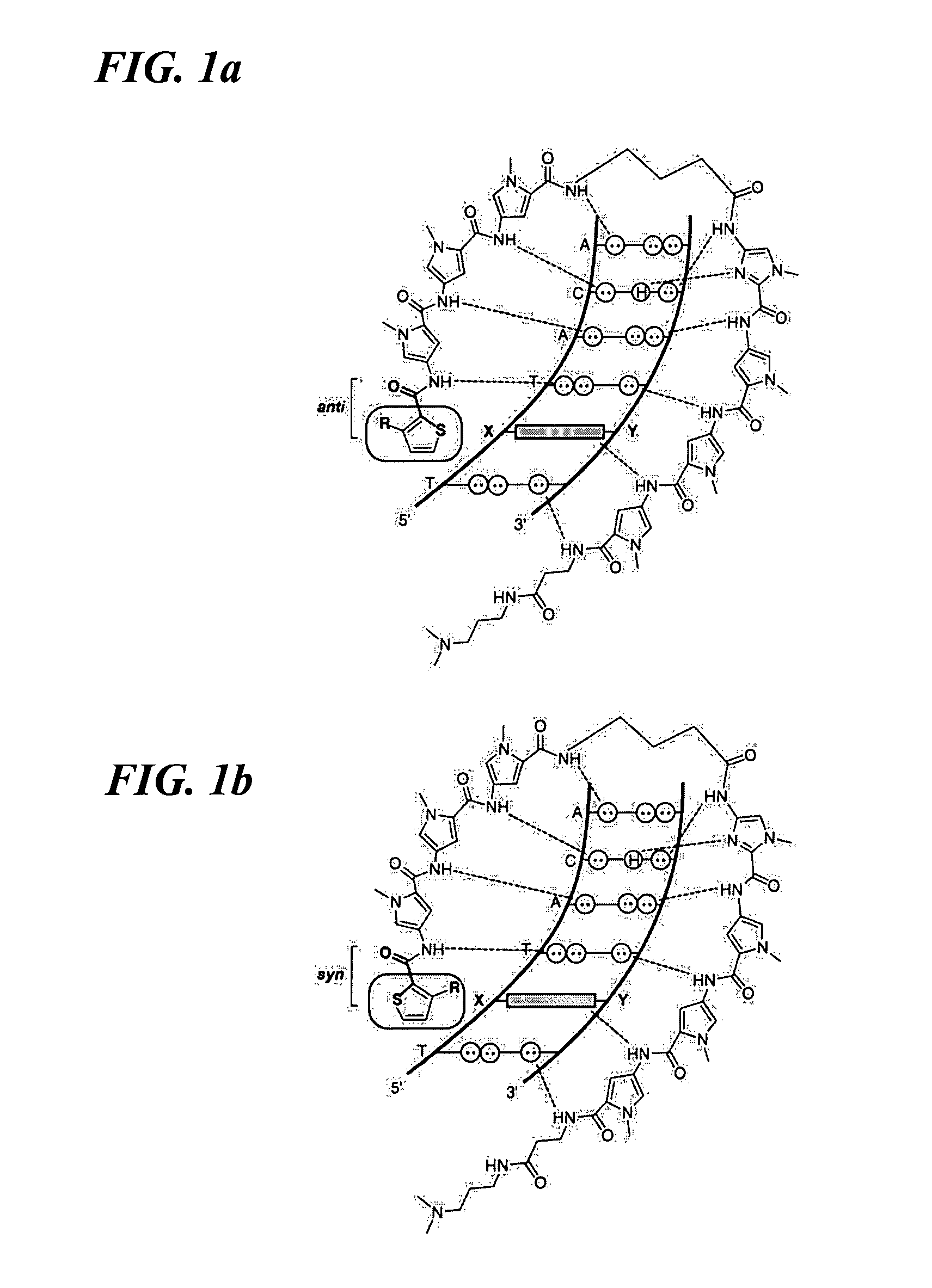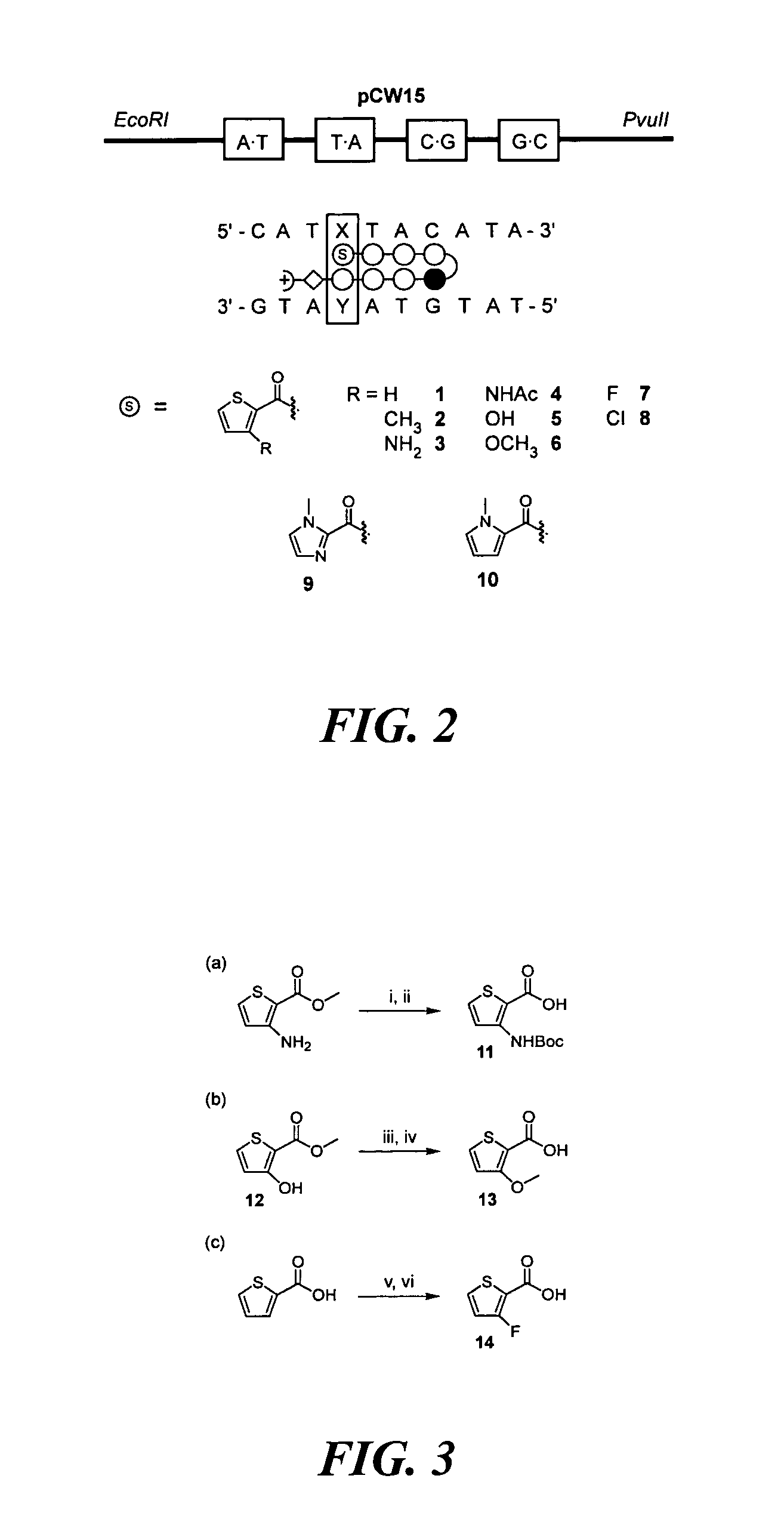DNA-binding polymers
a polymer and dna technology, applied in the field of dna-binding polymers, can solve the problems of many sequences remaining difficult to target, compounds that do not recognize specific nucleotide base pairs across the duplex, and presumably sterically unfavorable, so as to reduce the transcription level of a target oncogen
- Summary
- Abstract
- Description
- Claims
- Application Information
AI Technical Summary
Benefits of technology
Problems solved by technology
Method used
Image
Examples
example 1
Synthesis of Representative Thiophene-Containing Monomers
[0196]Methyl 3-aminothiophene-2-carboxylate was Boc-protected and the resulting ester was saponified to yield 3-[(tert-butoxy)carbonylamino]-2-thiophene-carboxylic acid (11). Methyl 3-hydroxythiophene-2-carboxylate (12) was prepared by cyclization of methylthioglycolate and methyl-2-chloroacrylate in methanolic sodium methoxide (Huddleston et al., Synth. Commun. 1979, 9, 731). Alkylation of (12) with iodomethane and subsequent hydrolysis of the methyl ester yielded 3-methoxy-2-thiophenecarboxylic acid (13). 3-Fluorothiophene-2-carboxylic acid (14) was synthesized as described by Taylor et al. (Org. Prep. Proc. Int. 1997, 29, 221) (FIG. 3A, 3B, 3C). The remaining 3-substituted-thiophene-2-carboxylic acids were obtained from commercial sources.
[0197]A. Preparation of 3-[(tert-Butoxy)carbonylamino]-2-thiophenecarboxylic Acid (11)
[0198]A mixture of methyl 3-amino-2-thiophene-carboxylate (2.53 g, 15.9 mmol), Boc2O (7.64 g, 35 mmol)...
example 2
Synthesis of Representative DNA-Binding Polymers
[0205]Resin (R1) was prepared using manual solid-phase synthetic techniques described previously (Baird et al., J. Am. Chem. Soc. 1996, 118, 6141). DNA-binding polymers were synthesized from intermediate resin (R1) that was prepared according to published protocols using Boc-β-alanine-Pam resin (50 mg, 0.59 mmol / g)(e.g., Baird et al., J. Am. Chem. Soc. 1996, 118, 6141).
[0206]A. Preparation of DNA-Binding Polymer (1)
[0207]Resin (R1) was treated with 80% TFA in dichloromethane and washed thoroughly. A solution of 2-thiophenecarboxylic acid (19 mg, 0.148 mmol) and HBTU (28 mg, 0.079 mmol) in DMF (0.45 mL) and DIEA (0.5 mL) was mixed at 40° C. for 25 min and poured onto the deprotected resin. The resin slurry was shaken for 4 h at room temperature and filtered. After washing with DMF, the resin was cleaved with Dp (1 mL) at 40° C. for 4 h. The crude product was purified by reversed-phase HPLC to afford (1) as a white solid upon lyophilizat...
example 3
DNA Binding Energetics of Representative DNA-Binding Polymers
[0226]A. DNA Reagents and Materials for DNase Footprinting
[0227]Oligonucleotide primers SF1 (5′-AATTC-GAGCTCGGTACCGGGG-3′; SEQ ID NO:1) and SF2 (5′-CTGGCACGACAGGTTTCCCGA-3′; SEQ ID NO:2) were synthesized by the Biopolymer Synthesis Center at the California Institute of Technology. Products from PCR amplification of the pCW15 using 5′-[γ-32P]-labeled SF1 and SF2 were purified on a 7% non-denaturing polyacrylamide gel. Glycogen (20 mg / mL), dNTPs (PCR nucleotide mix), and all enzymes, unless otherwise stated, were purchased from Boehringer-Mannheim. Deoxyadenosine [γ-32P]triphosphate was obtained from ICN. Calf thymus DNA (sonicated, deproteinized) and DNase I (7500 units / mL, FPLC pure) were from Amersham Pharmacia. AmpliTaq DNA polymerase was obtained from Perkin-Elmer and was used with provided buffers. Tris.HCl, DTT, RNase-free water, and 0.5 M EDTA were from United States Biochemical. Calcium chloride, potassium chloride,...
PUM
| Property | Measurement | Unit |
|---|---|---|
| temperatures | aaaaa | aaaaa |
| temperatures | aaaaa | aaaaa |
| temperature | aaaaa | aaaaa |
Abstract
Description
Claims
Application Information
 Login to View More
Login to View More - R&D Engineer
- R&D Manager
- IP Professional
- Industry Leading Data Capabilities
- Powerful AI technology
- Patent DNA Extraction
Browse by: Latest US Patents, China's latest patents, Technical Efficacy Thesaurus, Application Domain, Technology Topic, Popular Technical Reports.
© 2024 PatSnap. All rights reserved.Legal|Privacy policy|Modern Slavery Act Transparency Statement|Sitemap|About US| Contact US: help@patsnap.com










